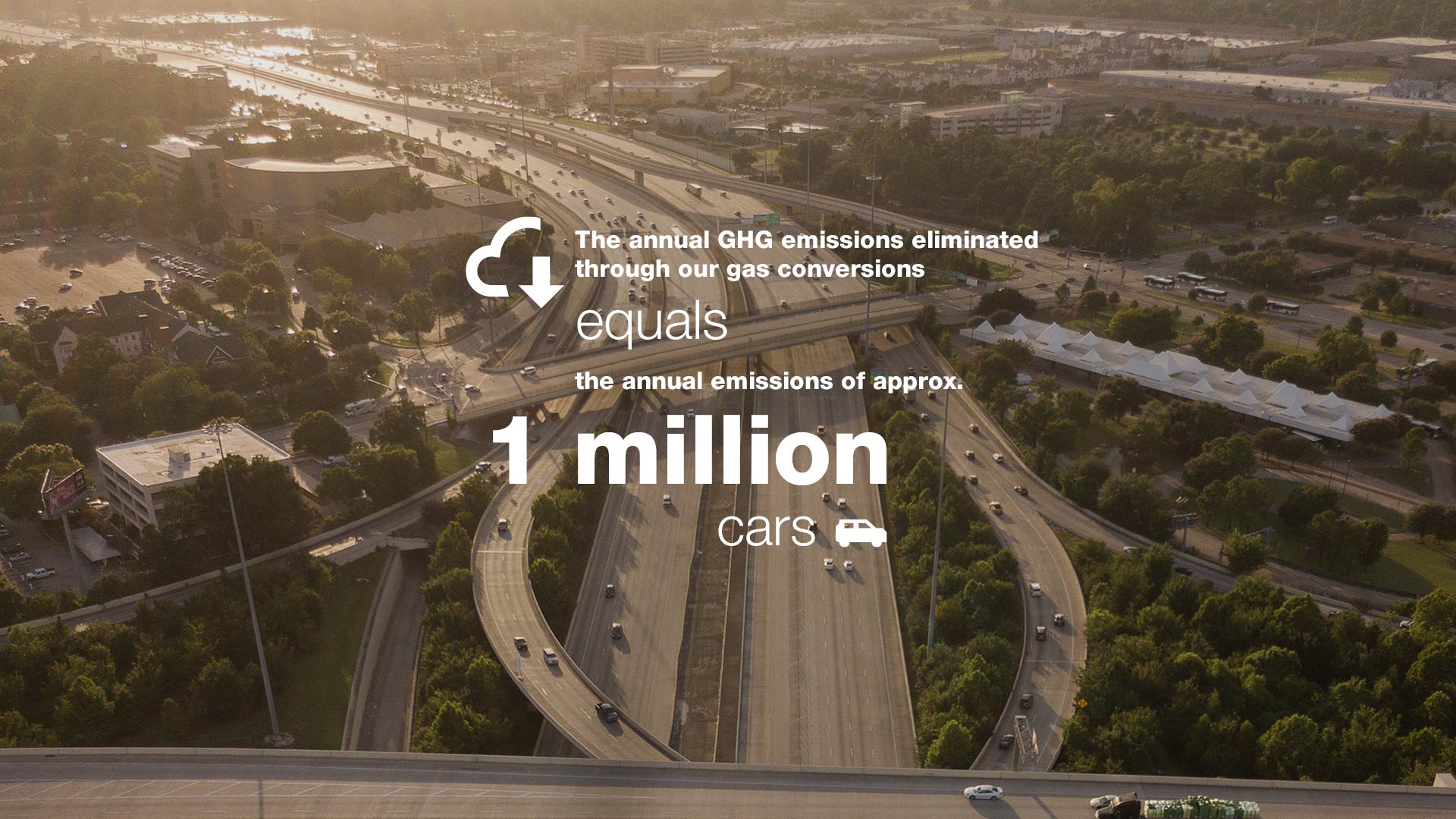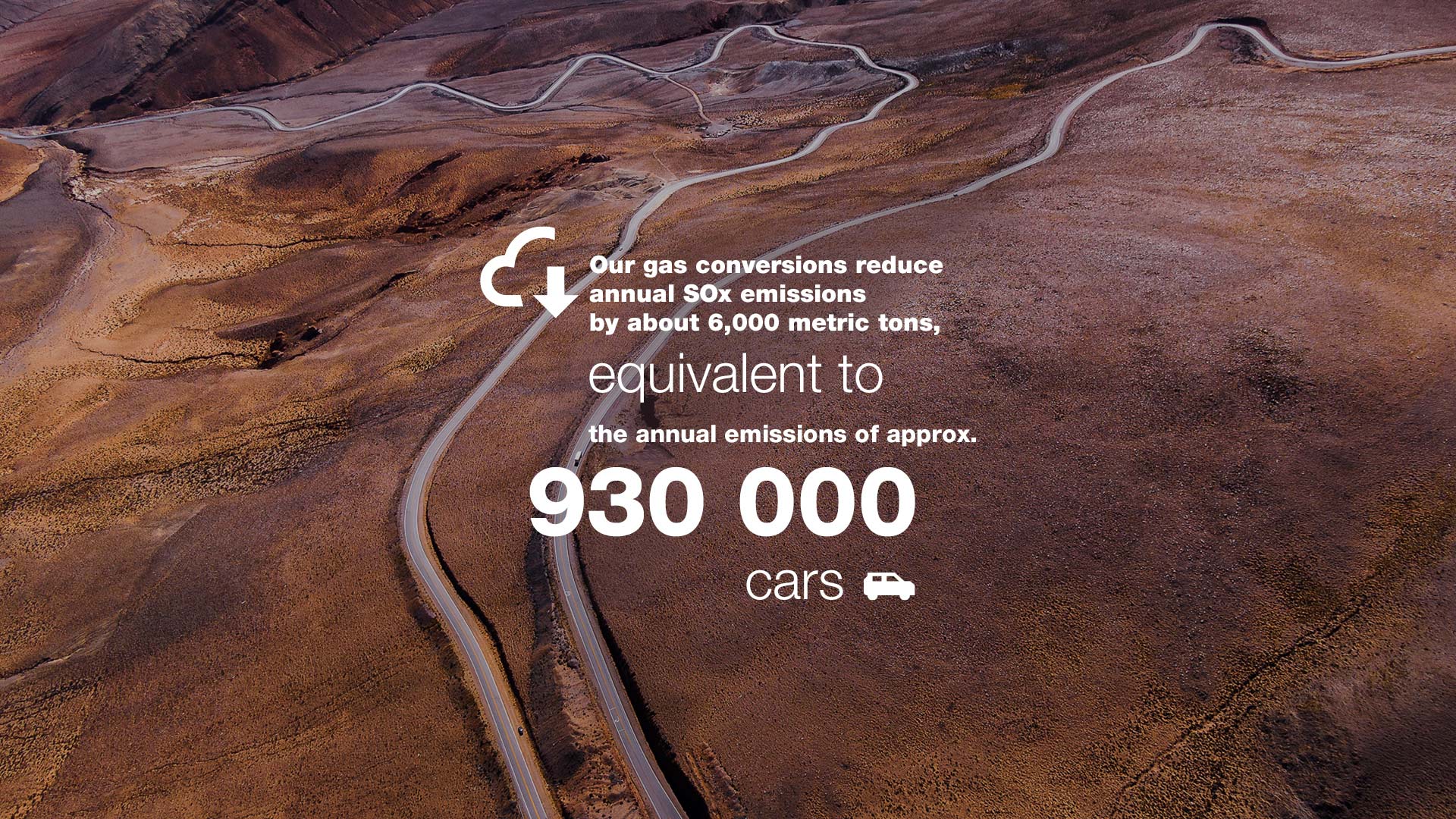

Wärtsilä specialises in gas conversion projects that make the switch from diesel to natural gas, LNG, and, ultimately, synthetic green fuels.
Presently, gas grids are expanding and allowed emission levels keep tightening – and conversion to natural gas is becoming an increasingly viable alternative for power plants. Transition from diesel to gas as a primary fuel is but the first step; in the horizon, there is the promise of synthetic renewable fuels as part of the emerging Hydrogen Economy. To achieve this green feat, one needs engines that are future proof: fully flexible and easily adapted to new fuels.
Since the early 2000’s, Wärtsilä has been helping power plants cut their operational costs and exhaust gas emissions while increasing fuel flexibility. A gas conversion can also be seen as a sustainable business move since it is likely to promote the addition of more renewables into the system.
Wärtsilä Energy has an extensive track record of successful conversion projects – over 100 engines worldwide are converted to run on gas. Tom Lindqvist, who leads the project business development within Wärtsilä Energy Services, says that 90-95% of these projects have involved conversion from diesel to gas or LNG (liquefied natural gas).
“Most conversions have been made to natural gas,” he says. At the time of the interview in late Spring 2021, there are five conversion projects on-going, with 32 already delivered.
“The total power generation of all these projects put together is 1,5 GW.”
Dynamic decarbonisation
According to Lindqvist, gas conversion is a “hot ticket” for a number of reasons. First of all, as natural gas is both attractively priced and efficient, converting an existing engine to operate on gas offers significant economic and environmental benefits.
The sustainability angle alone is tremendous. Looking at the carbon drop, it is estimated that the Green House Gas (GHG) emissions eliminated in 2020 by Wärtsilä’s gas conversion projects equal the annual emissions of approximately 1 million cars.
The reduction of nitrogen oxides (NOx) is even more impressive: in 2020, the delivered gas conversions resulted in an annual NOx reduction of an estimated 17,000 metric tons (equaling the annual emissions of approximately 134 million cars).
“Gas can also offer increased operational flexibility to the customer, as other fuels can still be used if needed,” Lindqvist points out.
Markus Ljungkvist, Vice President, Energy Services, observes that while we keep moving towards a more sustainable energy system, natural gas can, indeed, build some bridges to the future.
“Gas can become the required transitional fuel in many places, facilitating change,” says Ljungkvist.
Wanted: Flexible & Future-proof
Actually, gas conversion is often considered to be a key feature in future-proofing one’s power plant, as it enables transition to synthetic fuels at a later date. Extending the lifetime of the installation is also an important consideration in the big picture.
Furthermore, as power plants are looking to lock down new power purchase agreements, gas conversion might be something needed to sweeten the deal – also from the point of view of securing funding.
“Supporting the use of renewables is of the essence, and this is one way to do it,” says Tom Lindqvist.

Secure the right solution
Wärtsilä can offer various conversion options for power plants. For example, spark ignited (SG) gas engines are mono fuel and use natural gas, LNG, or LPG (Liquefied Petroleum Gas). “They represent a strong option where there is a secure supply of natural gas,” says Lindqvist.
Pure gas engines enable the highest efficiency and asset output with the lowest emissions. Dual-fuel (DF) engines can use multiple fuels: natural gas and LNG, and if need, HFO (heavy fuel oil) or LFO (light fuel oil).
“This is the best option when you want to achieve high efficiency – but you still want to be able to use liquid fuels as backup,” Lindqvist explains.
All Wärtsilä’s conversion options involve modifications to engines, electrical and automation systems and mechanical auxiliary systems. Lindqvist points out that a Wärtsilä gas conversion of an existing power plant is not just about the engine conversion – it follows, basically, the same principles as any new-build plant constructed by Wärtsilä would.
“This means, in essence, that all aspects, from safety to operational reliability, are taken into consideration in detail.”
Bring the whole package
This “total package” includes elements such as the turbochargers and charge air coolers, piping and valves, cylinder heads, pistons, connecting rods and camshafts.
Mechanical auxiliary system upgrades include installation of gas regulating unit(s), safety vents and exhaust gas ventilation unit(s). As part of the project, the cooling and compressed air systems may also require modification. Electrical and automation system upgrades include changes to the engine control system, Human-Machine Interface (HMI) system, and low voltage switchgear.
“We manage all phases of a gas conversion project as a full engineering, procurement and construction (EPC) solution, from feasibility studies, financing support – if needed – and solution proposals to execution planning and implementation,” emphasises Lindqvist.
Eye on the lifecycle
According to Lindqvist, the most convenient time to carry out a gas conversion is when a major engine overhaul is being planned.
“It’s worthwhile to contact us early in the planning phase, so we can develop the conversion project together. This way, Wärtsilä is able to bring all the added value of its networks and expertise to the project.”
Wärtsilä can also help out in crunching the numbers to find out whether such an investment is profitable – as well as fully assess all the pros and cons linked with the case.
“An important part of the process is, obviously, having proper discussions with the gas provider. Price of the gas must be lower than that of diesel to make it work,” Lindqvist says, adding that inexpensive gas does not automatically mean a green light for the entire project.
“You also need to have calculations on how much emissions will be decreased due to the conversion.”

Solid evolution
During the past 20 years, gas conversions have seen “ups and downs” in their development, Lindqvist observes.
“In early 2000’s, the gas infrastructure was developed to the extent that conversions got started, gradually gaining momentum. The last two years have been very active indeed,” Lindqvist tracks the evolution of the gas conversions.
Markus Ljungkvist notes that another thing that has changed over time is the attitude of the big LNG players: previously, LNG would be considered a good fit only for really big power plants.
“At first, an LNG project needed to feature about 0.5 GW, but now there is definitely a shift in the attitudes and also smaller plants are considered profitable enough for LNG,” Ljungkvist says.
“At the same time, there are more and more LNG providers and the global reach keeps improving.”
When conversion is king
Looking into the future of gas conversions, Lindqvist and Ljungkvist are optimistic.
“Expectations are running high. We’re clearly headed in the right direction and also new concepts are being developed. For example, we can do additional upgrades such as a tailored heat recovery upgrade along with the conversion that further reduces GHG emissions,” says Lindqvist.
Conversion can be a viable solution in many cases, and a way to make the most out of the existing assets; it might be that investment in a new plant is not an option.
“Instead of building a totally new power plant, a gas conversion might well do the trick more efficiently. Furthermore, it is a way to future-proof the existing asset, a step towards increasing renewables into the system and lessening the environmental impact”, he adds.
Gas conversion showcases Wärtsilä’s vision of working towards a 100% renewable energy future. “In addition to being a viable and sustainable solution today, it also takes the forward-looking power plant owner one step closer to taking the advantage of future fuels,” Lindqvist concludes.
Related solutions
Did you like this? Subscribe to Insights updates!
Once every six weeks, you will get the top picks – the latest and the greatest pieces – from this Insights channel by email.

